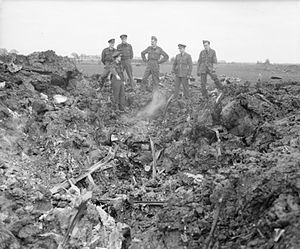Operation Steinbock
| Operation Steinbock | |||||||
|---|---|---|---|---|---|---|---|
| Part of World War II | |||||||
|
Air Marshal Sir Roderic Hill inspects the wreckage of a Junkers Ju 188E-1 belonging to 2 Staffel Kampfgeschwader 6 (Bomber Wing 6) which crashed in Essex, 21 March 1944. |
|||||||
|
|||||||
| Belligerents | |||||||
|
|
|
||||||
| Commanders and leaders | |||||||
|
|
|
||||||
| Strength | |||||||
| ~ 25 squadrons | 524 bombers | ||||||
| Casualties and losses | |||||||
| 1 destroyed in combat 5 damaged in combat 1 to friendly-fire 22 aircraft lost to other causes |
329 destroyed | ||||||
Operation Steinbock (German: Unternehmen Steinbock, Baby Blitz) was a Second World War Luftwaffe strategic bombing campaign against southern England that took place from January to May 1944. It was the last strategic air offensive by the German bomber arm during the conflict.
In late 1943 the Allied Combined Bomber Offensive was gathering momentum against Germany. RAF Bomber Command under the leadership of Arthur Harris and the American United States Army Air Force were conducting a strategic bombing campaign day and night against German industrial cities. In retaliation, Adolf Hitler ordered Hermann Göring, commander-in-chief of the Luftwaffe, to prepare a bombing operation against the United Kingdom.
Christened Steinbock, the bombing offensive also served as propaganda value for the German public and domestic consumption. The operation ran parallel to Bomber Command's campaign against Berlin (November 1943 – March 1944).
Placed under the command of Generalmajor (Major–General) Dietrich Peltz, Luftflotte 3 (Air Fleet 3), the Germans assembled 474 bomber aircraft for the offensive. The attacks were mainly aimed at and around the Greater London area. In Britain, it was known as the Baby Blitz due to the much smaller scale of operations compared to The Blitz, the campaign against the United Kingdom in 1940–41. The operation began in January and ended in May 1944.
...
Wikipedia

